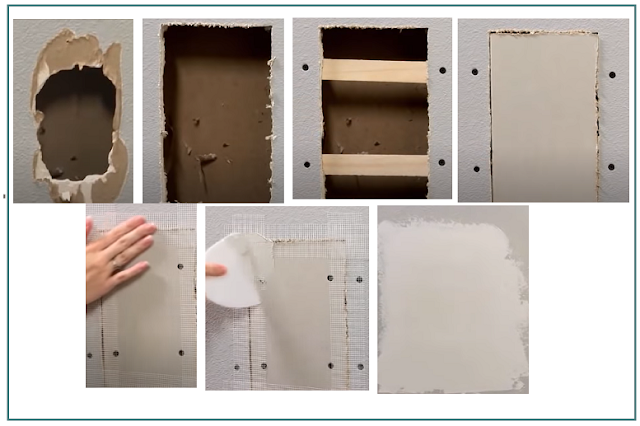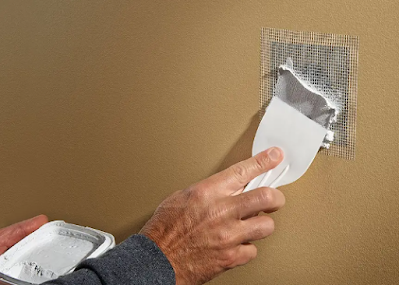Search This Blog
Most Popular
Plumbing Basics | Principle & Features
February 01, 2023
Shear Strength of Soil
February 02, 2023
Categories
- Building Construction (87)
- Building Materials (85)
- Columns (2)
- Concrete Beam (3)
- Concrete Construction Techniques (6)
- Concrete Mix Design (14)
- Concrete Repair (14)
- Concrete Slab (11)
- Construction Equipment (17)
- Construction News (7)
- Design of Structures (18)
- Engineering Drawing (1)
- Estimation (3)
- Geotechnical engineering (26)
- Highway Engineering (11)
- Innovations (34)
- Material Testing (11)
- Matrix Analysis of Structures (2)
- Mechanical Engineering (3)
- Strength of Materials (2)
- Structural Analysis (13)
- Structural Design (24)
- Structures (17)
- Transportation Engineering (9)
How to Patch Holes in Drywall?
Team Prodyogi
July 24, 2023
Whether it's an accidental dent or a hole created for hanging artwork, drywall damage is a common occurrence in every household. Fortunately, patching holes in drywall is a relatively simple DIY project that can save you money on professional repairs.
Step 2
Step 3
Step 4
Step 3
Step 5
Step 6
In this comprehensive guide, we will walk you through the step-by-step process of repairing both small dents and large holes in drywall. Let's dive in!
Gauging the Size of the Hole
Before you start any drywall repair, it's essential to assess the size of the hole to determine the appropriate repair method. Minor blemishes caused by fasteners, dings, or dents can be quickly patched with spackle or drywall compound using a putty knife. On the other hand, larger holes will require additional support for a successful patch.
How to Patch Very Small Holes and Dents in Drywall?
Step 1
Locate the Damage
Small dents and dings may not be immediately visible, so take the time to identify and mark all the damaged areas in the room.
Step 2
Fill the Hole, Dent, or Ding with Spackle
Use a putty knife to apply the spackle over the damaged area, ensuring it is completely filled.
Step 3
Wait for the Spackle to Dry
Follow the manufacturer's instructions for drying time, as prematurely sanding or painting can compromise the repair.
Step 4
Sand and Paint the Repair
Once the spackle is dry, sand the surface until smooth and then touch up with paint to match the existing wall color.
NoteA spackle, also known as a spackling compound, is a type of paste used to repair small holes, cracks, and imperfections in drywall surfaces. It is a crucial material in the process of patching up damaged walls and preparing them for painting or other finishing touches. Spackles are generally made of a gypsum-based or acrylic-based formula, and they are designed to be easy to apply and quick-drying.
How to Patch Small Holes in Drywall?
Step 1
Sand or Scrape the Edges of the Hole
Before applying the adhesive patch, make sure the edges of the hole are smooth to ensure a flush fit.
Step 2
Apply the Patch
Place the self-adhesive mesh patch over the hole, pressing it firmly against the wall.
Step 3
Spread the Spackle
Cover the patch with a spackle or lightweight joint compound, applying multiple layers if necessary for a seamless finish.
Step 4
Let the Spackle Dry
Wait for the spackle to dry completely before sanding and painting the patch to match the surrounding wall.
How to Patch Large Holes in Drywall?
 |
| Steps to Patch Large Holes in Drywall |
Step 1
Measure and Cut a Piece of Drywall
Measure the hole and cut a new piece of drywall that slightly exceeds the hole's size.
Step 2
Cut the Drywall Around the Hole
Trace the patch onto the wall and use a drywall saw to cut the hole to the correct size and shape.
Step 3
Install Furring Strips
Cut and install thin strips of wood inside the wall on both sides of the hole to provide support for the patch.
Step 4
Attach the Patch to the Furring Strips
Secure the new drywall patch to the furring strips using drywall screws and a drill.
Step 5
Apply Joint Tape and Joint Compound
Strengthen the repair by using mesh joint tape and covering it with joint compound.
Step 6
Let Dry, Then Sand and Paint
Allow the joint compound to dry completely before sanding and painting the patch to match the existing wall texture.
Conclusion
Patching holes in drywall is a valuable skill that every homeowner should master. Whether it's a small dent or a large hole, the step-by-step process outlined in this guide will help you achieve seamless repairs.
With the right tools and techniques, you can tackle drywall damage with confidence and keep your walls looking like new. Remember to take your time, follow the manufacturer's instructions, and don't be afraid to seek professional help for more extensive repairs. Happy patching!
Most Visited
Soil Sampling Methods| Undisturbed and Disturbed Samples
November 08, 2023
Boring Methods for Soil Exploration
November 02, 2023
Steel Column Connected to Concrete Masonry Wall
October 11, 2017
What are Infiltration Wells?
April 15, 2024
How to Choose Good Quality Aggregates for Construction?
August 10, 2021
Terzaghi's Equation: Soil Bearing Capacity for Foundations
March 02, 2022
Structure of Timber |Macrostructure and Microstructure
March 22, 2024
Search This Blog
MUST READ
What is PERT? Objectives, Pros & Cons
September 10, 2017
Terzaghi's Equation: Soil Bearing Capacity for Foundations
March 02, 2022
Contact Form
Footer Menu Widget
Created By SoraTemplates | Distributed By Gooyaabi Templates


0 Comments
Commenting Spam Links Are Against Policies